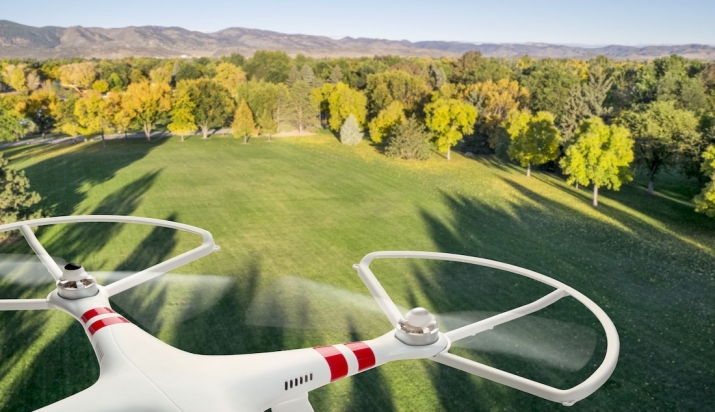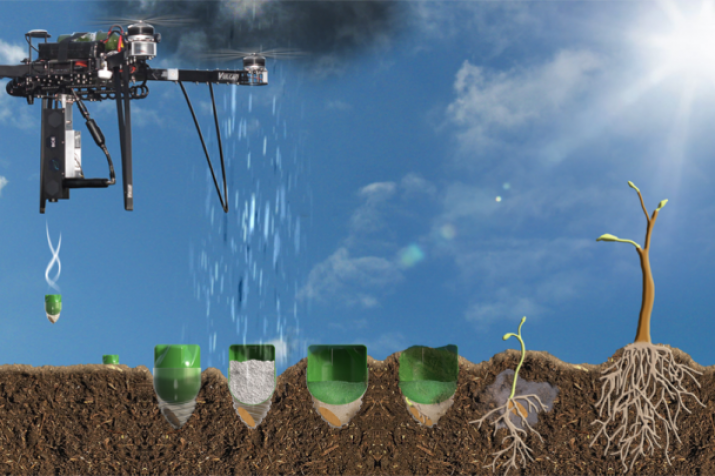NEWS
Can Tree-planting Drones Help Save the World’s Forests?
 Could fleets of tree-planting drones keep pace with industrial-scale deforestation? From nextnature.net
Could fleets of tree-planting drones keep pace with industrial-scale deforestation? From nextnature.net“Changing the world 1 billion trees at a time” may sound like over-ambitious hyperbole, but that is exactly what UK-based startup BioCarbon Engineering has set out to achieve by using drone technology to seed up to 1 billion trees year—“tackling industrial scale deforestation with industrial scale reforestation.” (BioCarbon Engineering)
Of the seemingly unending list of manmade environmental threats facing our planet, one of the most pressing is that of deforestation—the permanent destruction of forests to clear land for other uses, such as agriculture or expanding urbanization. Although the damaging impacts of this practice are well documented, deforestation continues on a massive scale. According to the United Nations’ Food and Agriculture Organization (FAO), an estimated 18 million acres of forest (more than 72,800 sq km; an area roughly the size of Panama) are lost each year, with tropical rainforests disappearing the most rapidly. NASA has projected that unchecked deforestation could completely deplete the world’s rainforests in as few as 100 years.
An estimated 26 billion trees are lost each year to lumber, mining, agriculture, and urban expansion, while only 15 billion are replanted. In part, the reason for this discrepancy is because planting seeds by hand is a slow, costly, and labor-intensive process, while dry-seeding using traditional aircraft typically results in a low success rate. BioCarbon Engineering believes it can revolutionize reforestation through the use of specially-modified drones.
“The only option that we’ve had previously has been hand-planting, which is slow and really expensive and just can’t keep up with industrial-scale deforestation, and so we’re hoping that out technology is going to provide opportunities to really scale up the reforestation and replanting rates,” said BioCarbon Engineering CEO Lauren Fletcher, a former NASA engineer. “The only way we're going to take on these age-old problems is with techniques that weren’t available to us before. By using this approach we can meet the scale of the problem out there.” (YouTube, Independent)
The drone reforestation process is carried out in three operational stages: 3D aerial mapping to determine the optimal target areas and timing for seed uptake, seed delivery by air, and follow-up flights after planting to monitor the success of the seedlings. The seeding flights take place 2–3 meters above the ground, duing which the drones fire out biodegradable pods containing pre-germinated seeds enveloped within a nutrient-providing hydrogel.
“Our mapping drones track the topography and the soil types, and we work with ecologists to ensure that what we're planting is the right species,” Fletcher observed. “We want the highest yield proportion and to protect the biodiversity.” (Wired)
Fletcher projects that two operators manning multiple drones simultaneously could plant up to 36,000 trees in a single day—compared with two human planters, who might plant up to 3,000 seeds per day—and at just 15 per cent of the cost of traditional seeding methods.
In the next 5–7 years, Fletcher targets 100 two-member teams, which would be able to plant 1 billion trees a year over an are of some 500,000 hectares. By working with ecologists, BioCarbon Engineering plans to use its technology to distribute not only trees, but microorganisms and native fungi. “The central focus is ecosystem restoration,” said Fletcher. (Wired)
 The drones launch germinated tree seeds in biodegradable pods. From biocarbonengineering.com
The drones launch germinated tree seeds in biodegradable pods. From biocarbonengineering.comSee more
Re-Planting a Forest, One Drone at a Time (Wired)
Drones could help save the world's forests (Wired)
Ex-Nasa man to plant one billion trees a year using drones (Independent)
NASA scientist is using drones to plant 1 billion trees per year (Global Citizen)
BioCarbon Engineering
Related
Buddhist Monks Working to Tackle Deforestation in Cambodia (Buddhistdoor Global)
The Interconnected World of Trees (Buddhistdoor Global)
Bhutan Plants 108,000 Trees to Celebrate Birth of Crown Prince (Buddhistdoor Global)
Cambodian Monk Launches International Appeal to Save Country’s Forests (Buddhistdoor Global)
Reforestation: Creating a Greener World (Buddhistdoor Global)














